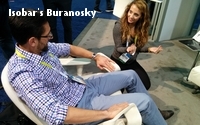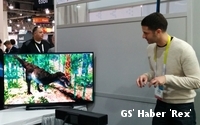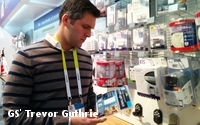Scouting Report: Why Cookies Were CES' Next Big Thing
- by Joe Mandese @mp_joemandese, January 25, 2015
 LAS
VEGAS -- “This is going to be the biggest thing here,” David Meeker, head of innovation for Isobar, said to me while walking the floor at the recent CES convention. “It might be the
one business in here that’s guaranteed to make $1 billion next year.” Meeker was one of a handful of knowledgeable agency executives I asked to walk the floor with me during the week-long
gadget-fest, so when he stopped in his tracks and began waving his hands excitedly, I turned to see what the next big thing was that caught his eye. The bright, shiny objects standing behind Meeker
weren’t robots, drones or some dazzling Star Trek-like gear. It was a small patrol of Girl Scouts manning a trademark green exhibit booth. And they were selling cookies.
LAS
VEGAS -- “This is going to be the biggest thing here,” David Meeker, head of innovation for Isobar, said to me while walking the floor at the recent CES convention. “It might be the
one business in here that’s guaranteed to make $1 billion next year.” Meeker was one of a handful of knowledgeable agency executives I asked to walk the floor with me during the week-long
gadget-fest, so when he stopped in his tracks and began waving his hands excitedly, I turned to see what the next big thing was that caught his eye. The bright, shiny objects standing behind Meeker
weren’t robots, drones or some dazzling Star Trek-like gear. It was a small patrol of Girl Scouts manning a trademark green exhibit booth. And they were selling cookies.The scouts (pictured in the accompanying photo) were too young to be identified by name, but they weren’t just selling Thin Mints, Do-Si-Dos and Tagalongs. They were selling what Meeker believes will be a billion-dollar e-commerce platform -- not just because of some state-of-the-art new technology, but because of the man-machine interaction. Make that girl-machine interaction.
advertisement
advertisement
After walking us through the Girl Scouts of America’s spiffy new e-commerce site, the scouts took us on a tour of its door-to-door interface, a special iPad version the scouts use for taking orders electronically, on-the-fly.
Like the Girl Scouts, much of what caught Meeker’s fancy were not necessarily high-tech gizmos, but things
that evoked incredibly human connections. One of his favorite CES installations was a simple leather lounge chair designed to help people get fit via resistance training. The chair (pictured below
with Meeker’s colleague Paul Buranosky) was one of several products on display by a company called T AO that designs gear that people interact with by exerting physical pressure (a chair, a video game joystick, etc.) to get an isometric workout reinforced by data on digital
screens.
AO that designs gear that people interact with by exerting physical pressure (a chair, a video game joystick, etc.) to get an isometric workout reinforced by data on digital
screens.
Another of Meeker’s favorites was a wooden orb that looked like it would be more at home in a yoga studio than on the CES floor. The orb, along with other polished wooden objects (a scale, a wearable fitness tracker) were created by Bellabeat, a company that makes quantified self technology designed to be warm and friendly for women and to follow them throughout their lives.
The orb, called a Bellabeat Shell, serves multiple purposes. It operates as a prenatal fetus monitor while a woman is expecting, and then becomes a postnatal baby monitor when the child is born. The Shell plays music to the fetus while it is gestating, and then uses the same sounds to soothe the infant to help regulate its sleeping patterns in its nursery. Turned on one side, it is a speaker that plays sound effects and lullabies for babies. Turned on its other side, it is an intercom that can alert parents when the baby is crying and utilizes algorithmic processing to tell the parents why.
“What I like about it is that it shows how a device moves through somebody’s life. Its functions change as your life continues,” says Meeker, who also oversees Isobar’s Nowlab, so his impressions of the CES gadgets were not just theoretical. They were all based on understanding how the technologies and designs on display could work into the lives of customers of Isobar’s brands.
That was a similar theme advanced by the team from Giant Spoon that I also followed around for part of a day at CES. The Giant Spoon team also were less impressed by the robots walking and flying drones zigzagging around the convention floor. They were more interested in how technological innovation was contributing to changes in the way people interact with products, services and brands.

“It’s a process of absorption and creation,” says Giant Spoon partner Jon Haber. “First we absorb information about what’s new -- what’s changing. Then we create things from that knowledge.”
Haber says it can take several years before the right ideas catch up with the consumer branding marketplace, but that it’s important to be there at the earliest stages so that the agency and its clients have a framework for what’s possible later when it becomes relevant or applicable.
“You have to nurture the absorption process,” he says, adding: “We just store as much information in our brains as possible and wait for the right idea for the right product to spark.”
Haber’s partner Alan Cohen noted that is exactly what happened at the last CES when trends like wearable devices and smartwatches began to emerge, but are only now becoming explicitly applicable for brand marketing.
“You see it here first, but you don’t necessarily know how it’s going to come back and spark things later,” he says, estimating that of all the gear and gadgets on display at CES, only about 70% may have any relevant intelligence for agencies and brands.
“In terms of today -- or during 2015 -- it may only be about 5%,” he adds.
Among the meta trends at this year’s convention that did catch the eye of the Giant Spoon team was the migration from wearables to connected devices to the “connected home.”
They spent a considerable amount of time hanging out at Lowe’s display, where the do-it-yourself home improvement retailer has an array of consumer-friendly “connected” technologies that average people can buy today and install in their homes to make them smarter -- everything from intelligent thermostats to pet doors that sense when a homeowner’s pet needs to enter or leave their house.
 The
other extreme of the connected home was an exhibit by Savant featuring the ultimate state-of-the-art technology for integrating all the devices in your home -- everything from heating, lighting and
security systems to a homeowner’s personal media preferences -- all through a single dashboard monitoring and managing everything based on the user’s personal preferences. Wake up in the
morning and Savant’s systems turn bedroom, hallway and bathroom lights on at pre-set luminosities, reset the thermostat to a preferred temperature, pipe in ambient music and turn your TV screen
to your favorite morning news channel while the coffeemaker brews your favorite cup of Joe.
The
other extreme of the connected home was an exhibit by Savant featuring the ultimate state-of-the-art technology for integrating all the devices in your home -- everything from heating, lighting and
security systems to a homeowner’s personal media preferences -- all through a single dashboard monitoring and managing everything based on the user’s personal preferences. Wake up in the
morning and Savant’s systems turn bedroom, hallway and bathroom lights on at pre-set luminosities, reset the thermostat to a preferred temperature, pipe in ambient music and turn your TV screen
to your favorite morning news channel while the coffeemaker brews your favorite cup of Joe.
The problem with the Savant system, says Giant Spoon’s Haber, is that it isn’t for everyone -- at least not yet. It’s such a high-end system that it requires a professional contractor -- what Savant calls “integrators” to set the systems up.
Over time, Haber said those kinds of technological advancements will find their way into simpler and friendlier applications for everyday people. By then, the next wave of innovation will be pushing the envelope even further. In the meantime, he says, agencies and brands just need to absorb.


Joe,
I've read quite a few of your blogs over the years...couldn't get through this one because of all the typos...C'Mon Man!
Ken, thanks for taking the time to share your frustration. How many typos did it take before you gave up? Feel free to point some of them out so we can correct them for others.